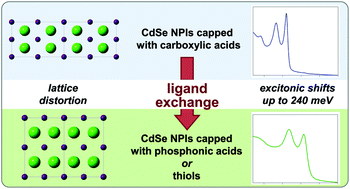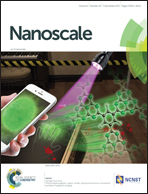A strain-induced exciton transition energy shift in CdSe nanoplatelets: the impact of an organic ligand shell†
Abstract
We study the influence of surface passivating ligands on the optical and structural properties of zinc blende CdSe nanoplatelets. Ligand exchange of native oleic acid with aliphatic thiol or phosphonic acid on the surface of nanoplatelets results in a large shift of exciton transition energy for up to 240 meV. Ligand exchange also leads to structural changes (strain) in the nanoplatelet's core analysed by wide-angle X-ray diffraction. By correlating the experimental data with theoretical calculations we demonstrate that the exciton energy shift is mainly caused by the ligand-induced anisotropic transformation of the crystalline structure altering the well width of the CdSe core. Further the exciton reduced mass in these CdSe quantum wells is determined by a new method and this agrees well with the expected values substantiating that ligand-strain induced changes in the colloidal quantum well thickness are responsible for the observed spectral shifts. Our findings are important for theoretical modeling of other anisotropically strained systems and demonstrate an approach to tune the optical properties of 2D semiconductor nanocrystals over a broad region thus widening the range of possible applications of AIIBVI nanoplatelets in optics and optoelectronics.



 Please wait while we load your content...
Please wait while we load your content...